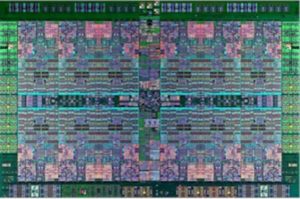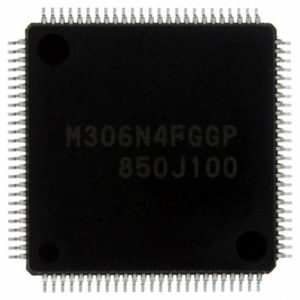Hack MCU IC Renesas MCU M306N4FCTFP
We can Hack MCU IC Renesas MCU M306N4FCTFP, please view the chip features for your reference:
1. Overview
The M16C/6N Group (M16C/6N4) of MCUs are built using the high-performance silicon gate CMOS process using the M16C/60 Series CPU core and are packaged in 100-pin plastic molded QFP and LQFP.
These MCUs operate using sophisticated instructions featuring a high level of instruction efficiency. With 1 Mbyte of address space, they are capable of executing instructions at high speed. Being equipped with two CAN (Controller Area Network) modules in the M16C/6N Group (M16C/6N4), the MCU is suited to drive automotive and industrial control systems.
The CAN modules comply with the 2.0B specification. In addition, this MCU contains a multiplier and DMAC which combined with fast instruction processing capability, makes it suitable for control of various OA, communication, and industrial equipment which requires high-speed arithmetic/ logic operations.
1.1 Applications
· Automotive, industrial control systems and other automobile, other (T/V-ver. product)
· Car audio and industrial control systems, other (Normal-ver. product)
1.2 Performance Overview
Table 1.1 lists the Functions and Specifications for M16C/6N Group (M16C/6N4).
Table 1.1 Functions and Specifications for M16C/6N Group (M16C/6N4)
|
Item |
|||
| CPU | |||
|
instructions |
|||
| Minimum instruction | |||
| Operating mode | |||
| Address space | |||
| Memory capacity | |||
|
Peripheral Function |
Ports |
||
| Multifunction timers | |||
| Serial interfaces | |||
| A/D converter | |||
| D/A converter | |||
| DMAC | |||
| CRC calculation circuit | |||
| CAN module | |||
| Watchdog timer | |||
| Interrupts | |||
| Clock generation circuits | |||
| Oscillation-stopped detector | |||
|
Electrical Characteristics |
Supply voltage |
||
| Consumption |
Mask ROM |
||
| Flash memory | |||
| Mask ROM | |||
| Flash Memory | |||
| Programming and erasure endurance | |||
|
I/O Characteristics |
I/O withstand voltage |
||
| Output current | |||
|
Operating Ambient Temperature |
|||
|
Device Configuration |
|||
|
Package |
|||
|
Specification |
|
|
Normal-ver. |
T/V-ver. |
|
91 instructions |
|
|
41.7 ns (f(BCLK) = 24 MHz, 1/1 prescaler, without software wait) |
1/1 prescaler, without software wait) |
|
Single-chip, memory expansion, and microprocessor modes |
|
|
1 Mbyte |
|
|
Refer to Table 1.2 Product Information |
|
|
Input/Output: 87 pins, Input: 1 pin |
|
|
Timer A: 16 bits ✕ 5 channels Timer B: 16 bits ✕ 6 channels Three-phase motor control circuit |
|
|
3 channels 2 (1) (2) Clock synchronous, UART, I C-bus , IEBus 1 channel Clock synchronous |
|
|
10-bit A/D converter: 1 circuit, 26 channels |
|
|
8 bits ✕ 2 channels |
|
|
2 channels |
|
|
CRC-CCITT |
|
|
2 channels with 2.0B specification |
|
|
15 bits ✕ 1 channel (with prescaler) |
|
|
Internal: 31 sources, External: 9 sources Software: 4 sources, Priority levels: 7 levels |
|
|
4 circuits · Main clock oscillation circuit (*) · Sub clock oscillation circuit (*) · On-chip oscillator · PLL frequency synthesizer (*) Equipped with on-chip feedback resistor |
|
|
Main clock oscillation stop and re-oscillation detection function |
|
|
VCC = 3.0 to 5.5 V (f(BCLK) = 24 MHz, 1/1 prescaler, without software wait) |
VCC = 4.2 to 5.5 V (f(BCLK) = 20 MHz, 1/1 prescaler, without software wait) |
|
20 mA (f(BCLK) = 24 MHz, PLL operation, no division) |
18 mA (f(BCLK) = 20 MHz, PLL operation, no division) |
|
22 mA (f(BCLK) = 24 MHz, PLL operation, no division) |
20 mA (f(BCLK) = 20 MHz, PLL operation, no division) |
|
3 µA (f(BCLK) = 32 kHz, Wait mode, Oscillation capacity Low) |
|
|
0.8 µA (Stop mode, Topr = 25°C) |
|
|
3.0 ± 0.3 V or 5.0 ± 0.5 V |
5.0 ± 0.5 V |
|
100 times |
|
|
5.0 V |
|
|
5 mA |
|
|
-40 to 85°C |
T version: -40 to 85°C V version: -40 to 125°C (option) |
|
CMOS high-performance silicon gate |
|
|
100-pin molded-plastic QFP, LQFP |
|
NOTES:
1. I2C-bus is a trademark of Koninklijke Philips Electronics N.V.
2. IEBus is a trademark of NEC Electronics Corporation.
option: All options are on request basis.



